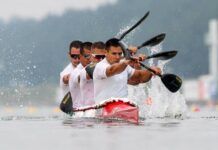Have you ever wondered how top golfers can hit the ball so far, so effortlessly?
Have you ever wondered how a baseball pitcher can throw such a fast ball? https://youtu.be/jZKvJY6gDfg
Have you ever wondered how a discus thrower can throw so far? https://youtu.be/a0lwtTGAEX4
Have you ever wondered how some Aussie Rules footballers can kick the ball over massive distances? https://youtu.be/e4KMzrirQo8
Look very closely at the body movements in these videos.
Whether it is hitting a golf ball, throwing a ball, kicking a football or paddling a dragon boat, the way you coordinate the different parts of your body is critical for getting the maximum speed out of your body.
This post will introduce you to Kinematic Sequences. Kinematics is the study of motion of objects (position, velocity, acceleration, etc.). In this post, the Kinematic Sequence is the order or sequence that you engage the different body parts during a golf shot, dragon boat stroke or any other proximal-to-distal sequencing of body segments.
This post is aimed at the more serious paddlers who have solid technique, strength and fitness who now wish to take it to the next level.
at the more serious paddlers who have solid technique, strength and fitness who now wish to take it to the next level.
Remember, we need to get the basics of the technique right first before trying this because if we don’t we will end up doing a poor technique very well. This would be fine if we are a lone paddler but we are not. We are in a crew striving to have everyone with the same technique.
Let’s Whip it Real Good
Let’s start with an example of a simple, pure kinematic sequence that we all know. Cracking a whip. Imagine the movement of a whip as it cracks. The handle is flicked forward and the tail follows smoothly all the way to the tip. The smooth pattern, or sequence, allows for the highest speed to be achieved at the tip of the whip, known as the summation of speed principle; where the speed increases as the energy is transferred down the length of the whip.
This sequence can be translated to dragon boating where the goal is to achieve maximum velocity. We utilize our body movement (kinematics) to maximize the energy transferred to the endpoint of the movement – our paddle. In dragon boating we use our legs (pelvis), torso, shoulder and arm.
The parts of your body that you use to move your paddle through the water represent the pathway of movement. Along this pathway we measure certain checkpoints that indicate how smoothly you are creating the whip effect.
The checkpoints are shown graphically as a kinematic sequence (summation of speed) shown below in an examples of a baseball throw and golf swing.

Graphics from: https://theperformancelabinc.wordpress.com/2014/09/16/the-kinematic-sequence/

Graphics from: https://theperformancelabinc.wordpress.com/2014/09/16/the-kinematic-sequence/
You will notice that although these are different sports the kinematic sequence graphs are very similar. To achieve maximum results the body segments not only have to fire off in a specific order but also at a specific time. Each subsequent body segment fires off at the peak of the preceding one.
Remember this:
When the speed of each successive segment or checkpoint peaks in a smooth order as shown in the graphs, the speed of the end point is maximized.
If one of the checkpoints does not fall in order, energy is lost and maximum speed is significantly reduced.
The key to an efficient transfer of energy in a dragon boat stroke is for each body segment to accelerate and decelerate in an orderly sequential manner.
Tuning your Kinematic Sequence
Body segment sequences can described in one of 3 ways:
…. The remainder of this content is for members only…














Fascinating analysis Mark…..being a failed golfer, I could actually ‘feel’ from the club/ball connect whether or not I’d hit the ball correctly. I’m not sure that I can actually feel that in my paddle stroke but I do understand that there are elements of the stroke that ‘fit’ together and I look forward to your further analysis. Illuminating! Thanks.
Thanks Geoff. From one “failed golfer”to another – I hear you. Have you ever had a training session where everything comes together and you feel like you are paddling smooth and strong? I know I have, and I believe these are the times when everything fires off in the right order at the right time. It probably happens more often than we think but because the boat is made up of others, this sweet spot may be missed in amongst the noise of the other paddlers seeking out the same nirvana but who are not quite there on the day. The joys of a team sport. Where I do HEAR the sweet spot often, is on the ergo, where on a good day the fan fair on screams. Cheers
Do you think the ergo would show this muscle memory? It always feels so different from the water especially with core balance, that I feel I compensate in other ways?
Actually, according to the author of Fast over 50 there is no such thing as muscle memory, it’s focus and remembering.
There are obviously differences between water resistance (paddling) and air resistance (ergo). Water is over 700 times more dense than air so the feedback you feel on the body is different. That said the sequence of body movement we are aiming for is the same and practicing on an ergo provides accurate measurements, greater visibility of your style and allows your body to experience the sequence before you get onto the water.